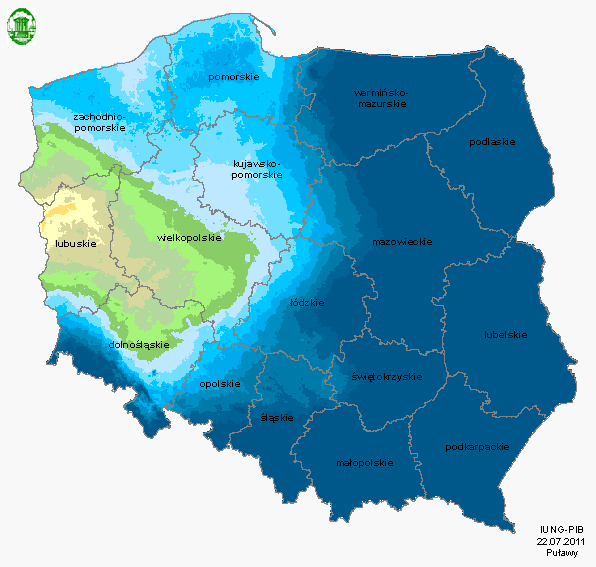ARCHIVES (2011)
Do roku 2016 raport oznaczony numerem 1 był tworzony za okres od 1 kwietnia do 31 maja. Od roku 2017 analizy są wykonywane o dekadę wcześniej czyli 1 raport oznacza okres od 21 marca do 20 maja
Communication report regarding the incidences of drought conditions in Poland
Year: 2011; period: 06 (21.V - 20.VII)
In the sixth reporting period, i.e. from 21 May to 20 July 2011, we have not found any risk of agricultural drought on Polish territory.
Despite the negative climatic water balance (CWB) values in almost all of Poland (with the exception of sub-Carpathian and Żywiec regions), the CWB values for crops included in the Agricultural Drought Monitoring System are much higher than the critical value.
Compared to the fifth report, there was a significant increase in the value of CWB in almost all studied localities. On average, CWB increased by 25 mm, which means that in the next sixty day period, the water deficit for crops decreased significantly and ranges from 0 (east) to - 130 mm (central Poland).
Only the coastal areas, and the Wschodniopomorski Lake District, and Chełmińsko-Dobrzynskie CWB- values decreased by 10-20 mm, which meant that the area of water deficit widened slightly. Nevertheless, the existing water reserves in the soil in the local district of this region are so high that it has not caused 20% drop in yield.
The area of greatest risk of drought is still in the Lubuskie voivodeship and the western part of Wielkopolskie voivodeship, although the water deficit in this area decreased by about 30 mm, ranging from -130 to -160 mm.
This year's June was warm. The warmest area was in central Poland from 18 to 19oC. Southern and northern air temperatures were lower at 17-18oC in the south and 16 - 17°C in the north. In Lower Silesia, the Wielkopolska and Mazowsze mid-air temperature was higher than the long-term average (1971-2000) by 2-2.5°C, and at Carpathian area by 1.5oC.
Precipitation in June was very diverse, ranging from very low (10-25 mm) in Wielkopolska, Dolnośląskie, Gdańsk coast, Północnomazowieckiej lowlands, Przedborski uplands and the Nida Basin, to high in the south-eastern and southern parts of the country, where it ranged from 50 to 120 mm (100-150% of normal).
The air temperature in the first ten days of July was low, especially in the south-eastern regions of the country and ranged from 15.5 to 16.5oC. The warmest was in Lubuskie and Wielkopolskie regions 17.5-19.0oC.
Precipitation in the first ten days of July was high or very high over a large area of the country. The greatest rainfall occurred in eastern Poland, especially in the north-east, reaching sizes of 60 to 120 mm. In western Poland there was less rainfall (30-60 mm), while the lowest occurred in the Koszalin Coastland (15-30 mm). In the second ten days of July rainfall was very variable, ranging from very high between Malopolska and Mazowsze, which ranged from 60 to 100 mm, and relatively low in Kujawy, Dolny Ślask, and in the west of the country and ranged from 20 to 40 mm.
Significant rainfall in June and July in the southern, southeastern and eastern parts of the country reduced the water deficit and contributed to the improvement of many crops. However, a large area of the country, especially in the province of Lubuskie and Wielkopolskie, where current losses are caused by a prolonged drought, will have significant declines in this year's yields for many crops.
Reports
- Report 13 (1.VIII - 30.IX)
- Report 12 (21.VII - 20.IX)
- Report 11 (11.VII - 10.IX)
- Report 10 (1.VII - 31.VIII)
- Report 09 (21.VI - 20.VIII)
- Report 08 (11.VI - 10.VIII)
- Report 07 (1.VI - 31.VII)
- Report 06 (21.V - 20.VII)
- Report 05 (11.V - 10.VII) +
- Report 04 (1.V - 30.VI) +
- Report 03 (21.IV - 20.VI) +
- Report 02 (11.IV - 10.VI) +
- Report 01 (1.IV - 31.V) +





